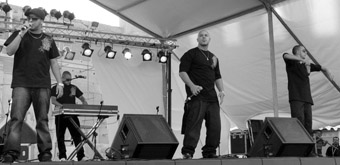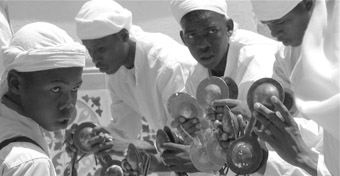nayda and the music of change
madeleine blackwell: moroccan music festivals

Fnaire, Fes festival
photo Madeleine Blackwell
Fnaire, Fes festival
I FIRST HEARD THE MUSIC OF MOROCCAN GROUP FNAIRE IN A TAXI IN FES, A “PETIT TAXI” AS THEY’RE CALLED LOCALLY. WHEN MY FRIEND AND I SHOWED SIGNS OF APPRECIATING THIS ENERGETIC MOROCCAN HIP HOP, THE DRIVER THROTTLED UP THE VOLUME, TURNED ON THE KITSCH DECORATIVE LIGHTS AND WE DROVE AROUND LIKE A MOBILE CHRISTMAS TREE, THUMPING OUT THE UBIQUITOUS HIP HOP BEAT TO WORDS IN A LANGUAGE I WRONGLY PRESUMED WAS ARABIC.
The taxi driver was so proud of the music that he gave us the CD and eventually dropped us off where we wanted to go—the opening concert of the Fes Festival of Sacred Music. Inside the ancient fortress walls of a caravanserai with a full moon above, the audience of local elites was thrown into a tizz by the late arrival of the Queen of Morocco and the renowned American diva Jessye Norman to open the program.
I was in Morocco to attend two music festivals: this glorious, highbrow festival in Fes and the Gnawa Festival in Essaouira which reveals the African face of Morocco. But that first grand concert was nowhere near as exciting as the taxi-ride, which introduced me to Moroccan hip-hop and to a dynamic social movement erupting all over Morocco today. The movement is known as “nayda” which means “it’s moving”—something’s on the move!
Nayda is a newly-coined word in a colloquial, unofficial language called Darija, or Moroccan Arabic, only spoken at home or on the street. It’s the language used in rap and hip-hop to express the heartfelt concerns of a generation who have been educated in French and Classical Arabic, languages inherited through ideology and the circumstances of history rather than the breath of their mother tongue. Nayda is an explosion of creativity from a generation who don’t want to flee to Europe, or risk their lives as illegal immigrants but rather choose to redefine the way they live and push for much needed democratic change.
In a huge public square just outside the ancient sand-coloured walls of the Medina of Fes, I got to see Fnaire live, with other hip hop artists including local heroes Fes City Clan. Thousands of young men edged to the front of the stage, mouthing the words, but more remarkable were the families with kids, old women wearing their hijab, young girls dancing in jeans, others dancing in the djellaba, a long cover all robe worn by men and women alike. Fes City Clan leapt about the stage with a patter about unemployment, corruption, the police and the impossible cost of living. In a country where half the population is illiterate their message was widely amplified.
Toc Toc, get up, your son is being beaten at the police station. Toc Toc, go and see. Some people have nice children, but you have a poor bastard who is stubborn, drugged with the pills he swallows. Thanks to him the dealers have built three storey villas with swimming pool, Turkish bath, chauffer waiting at the door. Toc Toc, get up.
Nothing can prepare you for the ambience of Essaouira, a small fishing port on the Atlantic coast where boats are all painted the same inky blue and weirdly oversized seagulls dominate the sky. There are no petit taxis, only pedestrians and hand-pulled carts fit inside the corridors of the ancient Medina. Now in its 11th year, the Essaouira festival’s proclaimed objective is “to fight for Gnawa culture and for cultural democratization in Morocco.” Directed by a brilliant young woman Neila Tazi, it has established the recipe for the plethora of mega-festivals that are sprouting up all over the country: free entry, high production values, investment in public space. The Timitar festival in Agadir celebrates Amazigh culture. In Casablanca L’Boulevard celebrates hip-hop and rap. Here in Essaouira it is the Gnawa.

A Gnawa troupe in Essaouira
photo Madeleine Blackwell
A Gnawa troupe in Essaouira
The Gnawa are descendents of black African slaves who were traded by the Berbers of the Sahara. Their polyrhythmic music is a ritual of trance and still has a religious function, to heal and exorcise entities that occupy the human body. Voodoo and Brazilian condomble share its roots, as does the American blues. The Gnawa Maalems, or ceremonial masters, come from all over Morocco to participate in this festival, beginning with a procession through the streets of the Medina. They play a three-stringed bass or ghembri and sing a melodic call which is replied to in unison by their entourage who layer the rhythm on metal castanets called qraqebs, evoking the chains of their slave forebears. Each night on the main stages their mesmerising music becomes a crossroad of experimentation and fusion. Great musicians of jazz, pop, rock and contemporary world music are invited to dialogue: Toumani Diabate, the Malian master of the chora, Wayne Shorter and his band from New York, and many more. Men, women, old and young, even small children dance en masse into altered states, as if wanting to be free of themselves.
The Nayda atmosphere continues into the night on the beach of Essaouira on a stage dedicated to the incorrigible hip-hop, rap, rai and fusion. Fes City Clan, Darga, H-Kayne, Ganga fusion…I have never seen so many dreadlocks in my life. The city is ‘occupied’ by young people, some from the tribes of the Sahara wearing turbans and robes, neo-hippies, baba-cools, punks clad in black, hip hoppers in their triple X T-shirts and running shoes. But I baulk at these categories. Identities can shift from one minute to the next, as they are shifting now throughout Moroccan society.
Morocco has recently emerged from the dark ages and the kids don’t want to go back there. Their parents endured “The Years of Lead”, so called because of the weight of exile, emigration, political repression, disappearances and death. While Nayda may look like Western decadence to its detractors, it certainly has roots in the radical popular movements of this era. In the 70s a group of musicians from the Rif mountains called Nass El Ghiwane personified resistance, carrying the voice of the Moroccan people through those dark years.
The current transition to democracy, overseen by King Mohammed VI, walks a fine line between the Islamic conservatives and the prescriptions of the International Monetary Fund and the globalised free trade market. The internet has had a momentous social impact, sometimes compared to the fall of the Berlin Wall. And in a country where 68% of the population is young, and many unemployed, there is an ideological battle to control hearts and minds. The youth and their music are constantly accused of being un-Moroccan. Some music festivals have provoked editorials in the Islamist press accusing them of “polluting the society with alcohol, hallucinogenic pills, men exchanging kisses, shameful, promiscuous women, and hysterical wobbling under the effect of musical trance.” In 2003, 14 rock musicians were put on trial for Satanism. Public sit-ins were held in their support; the charges were dropped.
But, as one of the musicians of rock/fusion group Hoba Hoba Spirit put it, “we love our country, we don’t want to ‘bruler’ (flee to Europe), we’re proud of being Moroccan but we’re not going to speak your sort of nationalism.” What is so intoxicating about the energy of all this music is the clear sensation that the artists are performing to assert their very existence, in a language of their own, revealing the diversity of contemporary Islam.
Fes Festival of World Sacred Music, artistic director Gerard Kurdjian, Fes, June 6-15, www.fesfestival.com; Festival Gnaoua, artistic director Neila Tazi, Essaouira, Morocco, June 26-29, www.festival-gnaoua.net
RealTime issue #87 Oct-Nov 2008 pg. 44






